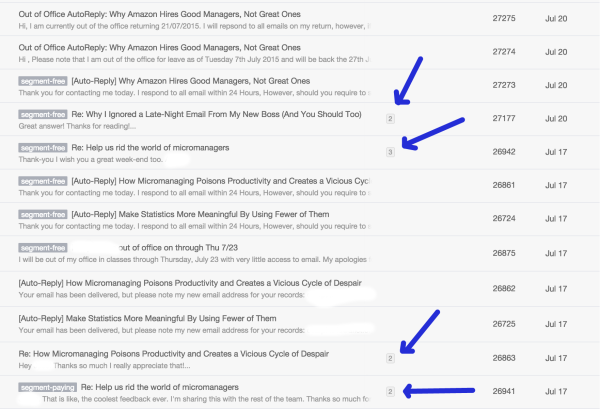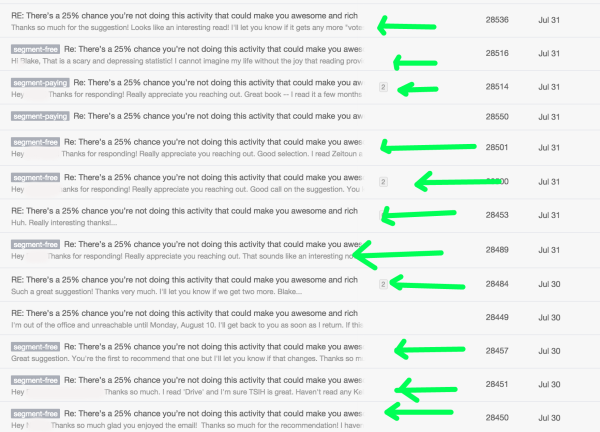By now you’ve heard all about the benefits of building an audience over an email list.
Let say you’ve even set up a Mailchimp account and built an awesome landing page for capturing emails. You’ve targeted the people you want to reach and aggressively marketed your landing page. You’re even starting to see some emails coming in. Your list is growing.
Now what?
One of the biggest challenges entrepreneurs and marketers have with their email list strategy is figuring out how to connect with people once they’ve signed up. Too boring, people unsubscribe. Too sales-y or pushy, people unsubscribe. Bother people too much and they’ll unsubscribe.
Never forget: the subscriber has the power in this relationship. They can unsubscribe whenever they want. It’s up to you to give them a reason to stay.
And subscriber engagement is more important than ever before. Top email providers like Yahoo and Google measure how many people are opening, reading and responding to you emails. This helps them decide whether or not your emails go to their spam folders.
So what do you do?
Here’s are the steps we took that got us 10X our email replies from our weekly newsletter here at iDoneThis. I totally stumbled on this strategy, but it works and launched meaningful conversations with more than 30 email subscribers.
1. Measure your current replies
How many people respond to your current emails? I’m talking about a real person actually decided to hit respond and say something. You’re responses probably look a lot like ours.
Here are two days of typical responses from our email lists.
You can see that out of 12 responses, only 4 are actual human responses. The rest are either out-of-office autoresponders or email management autoresponders.
I guess 25 percent isn’t bad, but only four engagements? Out of thousands of emails? Yikes.
2. Know your audience
The first step to getting people to take some action on your emails is getting them to open it. If you’re operating aboveboard, your subscribers signed up because they’re interested in what you have to say, not because they were tricked.
Buzzfeed, for example, does an excellent job with its newsletter strategy by offering 13 different newsletters, based on your interest. Rather than try to stuff everyone into one category — they give subscribers the choice based on what they’re interested in. This way, people interested in longform won’t be annoyed by emails full of cat gifs.
Read more on Buzzfeed’s email strategy in this excellent guide on Mailjet: The Buzzfeed Guide to Sending Irresistible Email
At iDoneThis, we know our audience is interested in remote work, entrepreneurship and startups. They want to be the best they can at work — whether the run the company or get the coffee. Usually their doing both.
Knowing this, I wrote a blog post on the reading habits of successful entrepreneurs. It’s all about how successful people like Bill Gates are ravenous book readers. The headline: “What Bill Gates and Mark Zuckerberg Love But 1 in 4 Americans Ignore”
3. Write a killer subject line
A great subject line — like a great headline — separates the clicks from the no thanks. “Check out our latest newsletter” is not a killer subject line.
I recently signed up for the hugely popular NextDraft newsletter from Dave Pell. I got the first email the other day. The subject line: “Toss Your Salad”
Woah! Just gotta find out what that’s about, right? (Turns out it was a reference to a story about lettuce — go figure).
For this email, I wanted a subject line that would promise value, but not over-promise and disappoint people once opened it up. I decided on something fun and conversational, that would make people want to engage.
The subject line: “There’s a 25% chance you’re not doing this activity that could make you awesome and rich”
4. Ask a specific question about a topic your subscribers are passionate about
The key to asking for feedback from your email subscribers is two-fold.
A. Ask a specific question.
B. Make it about something you know your subscribers are passionate about.
Too many emails and blogs end with, “tell us what you think.” That’s too general and doesn’t tap into what you know your readers like to talk about.
Here are a few examples:
If your newsletter is for: Electric guitar players
Don’t ask: Why do you like playing guitar?
Try asking: What components would be in your dream rig?
If your newsletter is for: Runners
Don’t ask: What do you think about distance running?
Try asking: What’s the longest distance you’ve ever ran?
If your newsletter is for: Entrepreneurs
Don’t ask: Share some advice for fellow entrepreneurs.
Try asking: What’s the best advice about hiring that you’ve ever received.
You see the pattern here? Specific questions make answers pop into your head quickly. The general questions are more vague, and take some time to chew on. Great fodder for a long dinner party, not for an inbox. People are going to pass altogether.
Considering the topic of my email, and knowing the audience, I put this question in my email: “Hit reply and let me know what book has been the most important to you.”
5. Offer something in return
You should always be offering your subscribers more value than your asking of them. Any time you find yourself asking for something (like a response or a conversion) consider how you can add some value, too.
In this email, I achieved this with one simple line: “If more than three people say the same book, I’ll read it and write a blog post about it.”
You can imagine how this is enticing for people. How many times do you read a great book and wish people around you would read it, too. The thought of some stranger on the internet reading a book because you too 8 seconds to hit reply is kind of fun.
But here’s the trick: you have to mean what you say. I was fully prepared to read The Iliad, The Old Testament, even an old phone book as long as three people suggested it. In fact, I was hoping for three suggestions.
In fact, I wasn’t intending on any of this to be any sort of strategy of “technique” from the beginning. I genuinely like knowing about books that mean a lot to people. Find those authentic areas where your interests intersect with your subscribers (it shouldn’t be hard — if it is you might be in the wrong job) and this all will be a breeze.
6. Watch the replies roll in, respond to all of them
The replies started rolling in almost immediately after this email went out. Let’s have a look.
There are the first 12 responses that came in after my email went out. It’s actually 13, but we’re ignoring the fourth one down since that’s a test response from my personal account.
You can see that out of these 12, a whopping 11 are actual responses! There’s only one auto response in the mix!
People were eager to share something specific that they were passionate about. I had no idea it would work so well.
Over all, I got more than 30 different people to reply with recommendations about books. I tracked all the recommendations in a spreadsheet along with their email addresses. Here are the books recommended (obviously I don’t want to publish the email addresses).
Not bad, considering a typical email for us generates only 1-3 actual responses.
Try this with your newsletter and I can promise, if you do it right, you’ll get more responses than usual. You’ll boost your newsletter status, get to know your readers, and keep your emails out of the spam filter.
P.S. If you liked this article, you should subscribe to our newsletter. We’ll email you a daily blog post with actionable and unconventional advice on how to work better.




